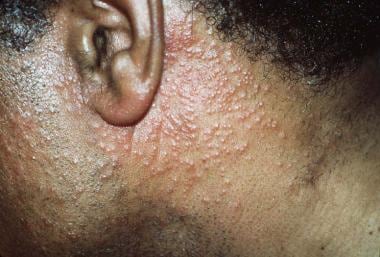Practice Essentials
Alopecia mucinosa, often referred to as follicular mucinosis, was first reported by Pinkus in 1957. [1] The dermatologic eruptions consist of follicular papules and/or indurated plaques that demonstrate distinct histologic changes in the hair follicles that lead to hair loss. The accumulation of mucinous material in the damaged hair follicles and sebaceous glands creates an inflammatory condition and subsequent degenerative process. The face, the neck, and the scalp are the most frequently affected sites, although lesions may appear on any part of the body.
The presenting sign of alopecia mucinosa is hair loss in hair-bearing areas. Skin eruptions present as pruritic, pink–to–yellow-white, follicular papules and plaques. Lesions may be isolated or multiple. Mycosis fungoides is recognized at the time of diagnosis in approximately 15-30% of patients with alopecia mucinosa.
Alopecia mucinosa represents various stages of follicular damage leading to hair loss. The reactive process is of unknown etiology. The role of circulating immune complexes and cell-mediated immunity has been considered.
Although the question of whether alopecia mucinosa is a transitional state evolving into mycosis fungoides is unresolved, it is proven that alopecia mucinosa may precede the development of mycosis fungoides by several years. Thus, additional biopsy specimens and extremely close follow-up care are crucial in all variants of alopecia mucinosa.
Treatments include topical, intralesional, and systemic corticosteroids.
Pathophysiology
Alopecia mucinosa is a disease process defined histopathologically by mucin deposition in hair follicles and sebaceous glands, which undergo epithelial reticular degeneration. The exact pathogenesis is unknown, although the role of circulating immune complexes and cell-mediated immunity has been considered. The 3 clinical variants of the disease consist of a primary acute disorder of young persons, a primary chronic disorder of older persons, and a secondary disorder associated with benign or malignant disease.
The primary disorder of young persons consists of focal cutaneous lesions with limited progression. Lesions are typically limited to the head, the neck, and the shoulders (see the image below). Most lesions spontaneously resolve between 2 months and 2 years. Pediatric cases comprise most of this type of alopecia mucinosa, with the remainder of patients being younger than 40 years. Neonatal follicular mucinosis has also been reported. [2]
Alopecia mucinosa may also manifest as acneiform lesions in young patients. This acneiform variant is typically benign and not associated with cutaneous T-cell lymphoma (CTCL) or mycosis fungoides. [3]
Primary chronic alopecia mucinosa of older persons affects people older than 40 years. Lesions have a widespread distribution, and they may persist or recur indefinitely. No associated disorders are identified.
The secondary alopecia mucinosa may be associated with either benign disease or malignant disease. These patients are usually aged 40-70 years, and the lesions are widespread and numerous. Alopecia mucinosa can occur secondary to benign disease, including the inflammatory conditions lupus erythematosus, lichen simplex chronicus, and angiolymphoid hyperplasia. Secondary alopecia mucinosa is also associated with malignant disease, including mycosis fungoides, Kaposi sarcoma, and Hodgkin disease; mycosis fungoides is by far the most common association. [4, 5, 6, 7] When the secondary form appears in children, it typically exhibits a more benign progression than in adults. [8]
In most patients who exhibit both alopecia mucinosa and mycosis fungoides, these conditions appear to develop concomitantly; however, the concern exists that individuals exhibiting only alopecia mucinosa may also be at risk for subsequent development of lymphoma.
Drug-induced alopecia mucinosa has been associated with the use of adalimumab [9] and imatinib. [10]
Epidemiology
Alopecia mucinosa is a rare condition. The precise data on its frequency are not available, but no racial predilection is reported. Although both sexes are affected by alopecia mucinosa, the disorder is more frequent in males than in females. Alopecia mucinosa in pregnancy has been reported. [11]
The 3 subsets of alopecia mucinosa are broken down by age, as follows:
-
Primary localized disease affects patients younger than 40 years and primarily occurs in the pediatric population. [12]
-
Primary generalized disease affects people older than 40 years.
-
Secondary disease with either a benign or a malignant association usually affects people in the fifth through eighth decades of life.
Prognosis
The prognosis of alopecia mucinosa depends on the specific clinical variant, as follows:
-
Primary acute disease usually disappears within 2 years; however, childhood alopecia mucinosa is not always self-limited and may possibly be related to Hodgkin disease.
-
Primary chronic disease usually lingers for several years, but it can fluctuate in the extent of skin involvement at any given time.
-
Secondary alopecia mucinosa has the least favorable prognosis when associated with coexistent malignancy.
Mortality is related to the coexistence of mycosis fungoides in secondary alopecia mucinosa. An estimated 15-40% of adults with alopecia mucinosa will eventually develop lymphoma, if they do not already have it. The malignant potential of alopecia mucinosa cannot be fully assessed because of the enigmatic nature of this and other cutaneous T-cell abnormalities. The morbidity of primary alopecia mucinosa is generally restricted to cosmesis, whereas in cases of secondary alopecia mucinosa, morbidity is related to the associated disease process.
A review of reports from a single cancer center revealed that alopecia mucinosa patients with hematologic malignancies other than cutaneous T-cell lymphoma (CTCL) showed clinical differences from alopecia mucinosa patients with mycosis fungoides. Specifically, the non-CTCL patients more commonly had plaque-free, reddened papules and no alopecia. This patient group also had no exocytosis identified on histopathology. [13]
-
Courtesy of Dirk M. Elston, MD.
-
Courtesy of Dirk M. Elston, MD.
-
Courtesy of San Antonio Uniformed Services Health Education Consortium (SAUSHEC) teaching files.










